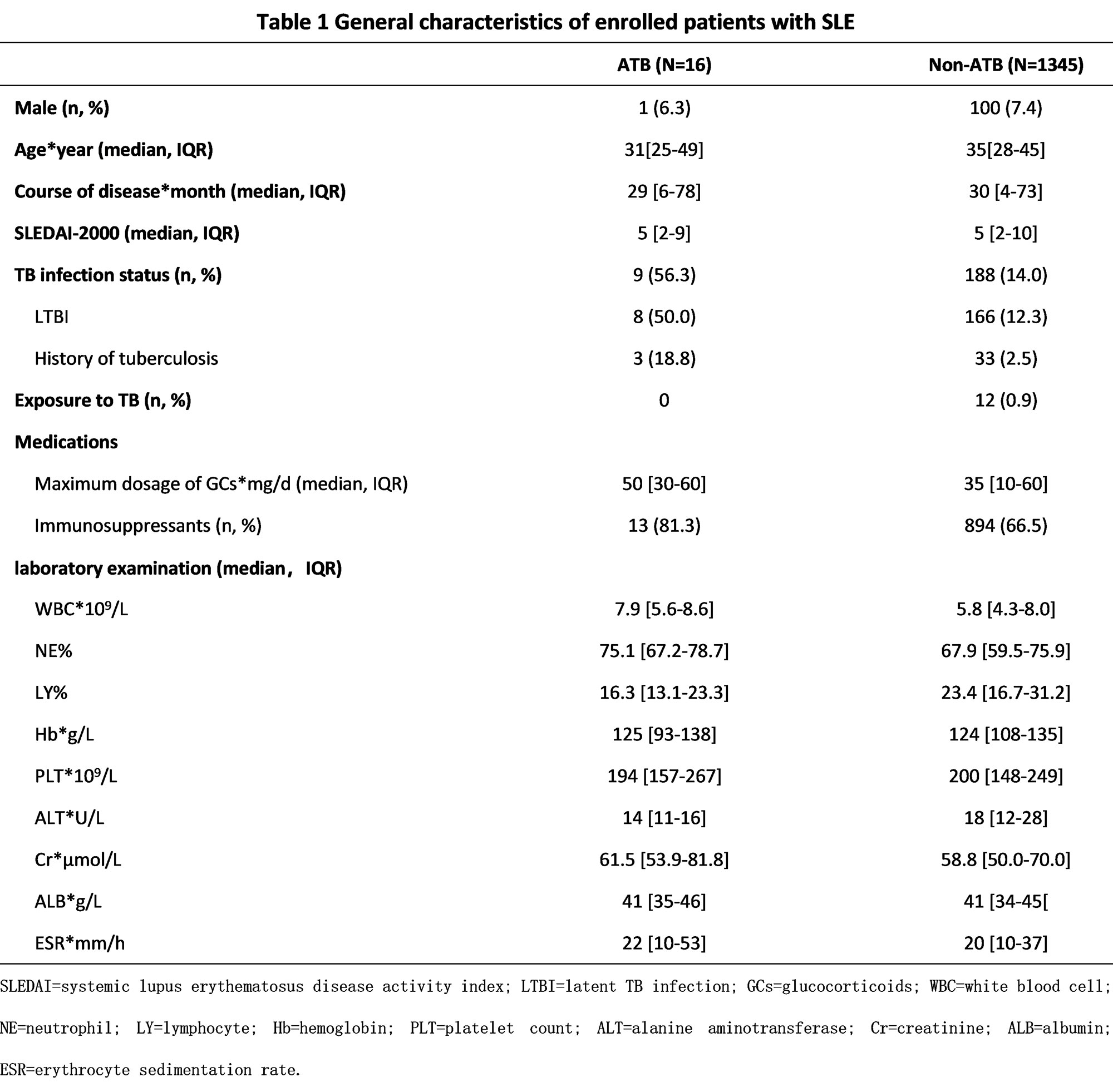Session Information
Date: Sunday, November 13, 2022
Title: SLE – Diagnosis, Manifestations, and Outcomes Poster II: Manifestations
Session Type: Poster Session C
Session Time: 1:00PM-3:00PM
Background/Purpose: The burden of tuberculosis (TB) and systemic lupus erythematosus (SLE) in China are both the second largest in the world. Patients with SLE are at high risk of developing TB, while there are no guidelines for prevention and management of TB in this population in China. This study aimed to investigate the incidence and explore the risk factors of active TB in patients with SLE, so as to provide evidence for the formulation of tuberculosis prevention and management strategies in patients with SLE in China.
Methods: We conducted a multicenter prospective cohort study. During September 2014 to March 2016, we recruited confirmed SLE outpatients and inpatients from 13 tertiary grade A general hospitals in eastern, central and western China. We collected baseline demographic characteristics, TB infection status, clinical diagnosis, treatment information, laboratory information and the incidence of active TB during follow-up. Survival curves were plotted using Kaplan–Meier method. Log-rank tests were used to assess the differences in the incidence of active TB. Risk factors for active TB disease were explored by the COX proportional risk model.
Results: Of the 1361 patients with SLE, 16 patients developed active TB and the median follow-up time is 59 months (IQR 56-63). The 1-year incidence of ATB in SLE patients was 367/100,000 (95% CI 119/100 000-855/100,000) and the 5-year cumulative incidence was 1125/100,000 (95% CI 631/100,000-1849/100,000). The results of COX multivariate regression analysis showed that the maximum daily dose of glucocorticoids (5 mg/day) (adjusted hazard ratio [aHR] = 1.14, 95% CI: 1.02-1.27, P = 0.019) and tuberculosis infection status (aHR = 8.71, 95% CI: 3.23-23.47, P < 0.001) were independent risk factors for active TB in patients with SLE, and that the lymphocyte percentage (aHR=0.94, 95% CI: 0.89-0.99, P=0.022) was a protective factor for active TB in patients with SLE.
Conclusion: The incidence of TB is higher in patients with SLE than in the general population. The risk of active TB in SLE patients is higher when the daily dose of glucocorticoids is increased or when they are in TB infection status. Therefore, prevention and treatment of tuberculosis should be considered in SLE patients.
To cite this abstract in AMA style:
Zhang L, zou x, Xie L, Liu J, yang z, cao q, Li C, Sun X, ZHANG F, Zhao Y, Zeng X, Liu X. Incidence and Risk Factors for Active Tuberculosis in Patients with Systemic Lupus Erythematosus: A Multicenter Prospective Cohort Study [abstract]. Arthritis Rheumatol. 2022; 74 (suppl 9). https://acrabstracts.org/abstract/incidence-and-risk-factors-for-active-tuberculosis-in-patients-with-systemic-lupus-erythematosus-a-multicenter-prospective-cohort-study/. Accessed .« Back to ACR Convergence 2022
ACR Meeting Abstracts - https://acrabstracts.org/abstract/incidence-and-risk-factors-for-active-tuberculosis-in-patients-with-systemic-lupus-erythematosus-a-multicenter-prospective-cohort-study/



